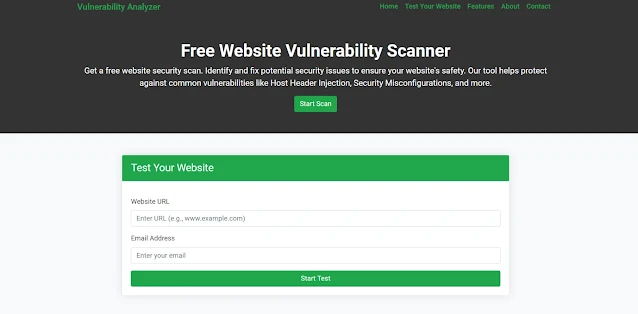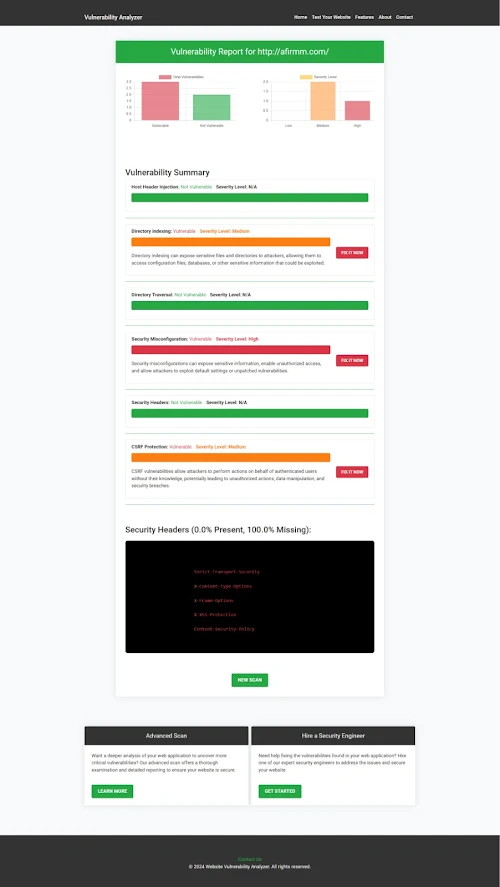WebSocket Vulnerabilities in Laravel: How to Prevent Them
Introduction
WebSocket is a powerful tool that enables real-time, bidirectional communication between a client and a server. It is particularly useful for applications like chat apps, live notifications, and real-time data streaming. However, WebSocket connections are susceptible to several vulnerabilities, especially when not implemented securely in frameworks like Laravel.
In this blog post, we’ll dive into common WebSocket vulnerabilities in Laravel and show you how to secure them. We’ll also provide a practical coding example to implement a secure WebSocket connection and explain how to use our Website Vulnerability Scanner tool to identify potential issues.
Common WebSocket Vulnerabilities in Laravel
-
Unauthorized Access
WebSocket connections are typically open and long-lived, meaning once a connection is established, it stays active. If not secured properly, unauthorized users might be able to gain access to sensitive WebSocket data. -
Insecure Data Transmission
If WebSocket connections are not encrypted (i.e., usingws://instead ofwss://), sensitive data can be exposed to attackers during transmission. -
Cross-Site WebSocket Hijacking (CSWSH)
This vulnerability arises when an attacker can hijack a WebSocket connection from another domain or user. -
Denial of Service (DoS)
Attackers can overwhelm the WebSocket server by sending malicious or excessive data, causing server crashes or slowdowns.
How to Secure WebSocket Connections in Laravel
To mitigate these vulnerabilities, follow these best practices for securing WebSocket connections in your Laravel application.
1. Use Secure WebSocket (wss://)
The first step is to ensure that your WebSocket connection uses SSL encryption. This can be achieved by using wss:// instead of ws://. Ensure that your Laravel application is served over HTTPS, and configure your WebSocket server to support secure connections.
let socket = new WebSocket("wss://yourdomain.com/socket");
This ensures that all data transmitted between the client and server is encrypted, protecting it from man-in-the-middle attacks.
2. Authenticate WebSocket Connections
Authentication is crucial for preventing unauthorized access. Laravel offers several ways to authenticate users, such as via API tokens, session-based authentication, or even Laravel's built-in Broadcasting system.
For example, using Laravel Echo with Pusher to authenticate WebSocket connections:
Broadcast::channel('private-channel', function ($user) {
return $user->id === 1; // Only allow authenticated users
});
This ensures that only authorized users can access the WebSocket connection.
3. Prevent Cross-Site WebSocket Hijacking (CSWSH)
To protect against CSWSH, ensure that your WebSocket server checks the Origin header in incoming requests. This ensures that the WebSocket connection is coming from a trusted source.
if ($_SERVER['HTTP_ORIGIN'] !== 'https://yourtrustedwebsite.com') {
die('Forbidden');
}
This step prevents attackers from connecting to your WebSocket server from unauthorized websites.
4. Rate Limiting & DoS Protection
To prevent DoS attacks, consider implementing rate limiting for WebSocket connections. You can do this using Laravel's middleware or even in the WebSocket server itself. For example, rate limit requests from the same IP:
Route::middleware(['throttle:60,1'])->get('/socket', function () {
// WebSocket connection logic
});
This limits the number of WebSocket connections a single IP can make in a given period.
Code Example: Implementing a Secure WebSocket in Laravel
Here’s a basic example of how you can implement a secure WebSocket in Laravel using Laravel Echo and Pusher.
- Install Laravel Echo and Pusher:
composer require pusher/pusher-php-server
npm install --save laravel-echo pusher-js
- Set up your
.envfile with Pusher credentials:
BROADCAST_DRIVER=pusher
PUSHER_APP_ID=your-app-id
PUSHER_APP_KEY=your-app-key
PUSHER_APP_SECRET=your-app-secret
PUSHER_APP_CLUSTER=your-cluster
- Create an event to broadcast over WebSocket:
use Illuminate\Broadcasting\Channel;
use Illuminate\Contracts\Broadcasting\ShouldBroadcast;
class MessageSent implements ShouldBroadcast
{
public $message;
public function __construct($message)
{
$this->message = $message;
}
public function broadcastOn()
{
return new Channel('chat');
}
}
- In your JavaScript, set up Laravel Echo to listen for the event:
Echo.channel('chat')
.listen('MessageSent', (event) => {
console.log(event.message);
});
With this setup, only authenticated users will be able to join the chat channel and the WebSocket connection will be secure.
How Our Free Security Tool Can Help
To further ensure the security of your Laravel application, you can use our free Website Security Scanner tool. This tool will scan your site for common security vulnerabilities and provide actionable insights.
Here’s a screenshot of our free security tool in action:
 |
| Screenshot of the free tools webpage where you can access security assessment tools. |
By checking your website regularly with this tool, you can identify weaknesses and vulnerabilities before attackers exploit them.
How to Generate a Vulnerability Assessment Report
After scanning your website, our tool will generate a detailed vulnerability assessment report to check Website Vulnerability. This report highlights any security issues detected on your site and offers suggestions on how to mitigate them.
Here’s an example of a vulnerability assessment report:
 |
| An Example of a vulnerability assessment report generated with our free tool, providing insights into possible vulnerabilities. |
This report helps you identify areas where your WebSocket connections or other parts of your Laravel application may be vulnerable.
Conclusion
WebSocket vulnerabilities in Laravel can put your application and users at risk if not properly secured. By following the best practices outlined above, you can ensure that your WebSocket connections are encrypted, authenticated, and protected against common attacks. Additionally, our tool provides a great way to regularly scan your site for a website security test and assess potential security risks.
For more security tips and best practices, visit our blog at Pentest Testing Blog.




Comments
Post a Comment